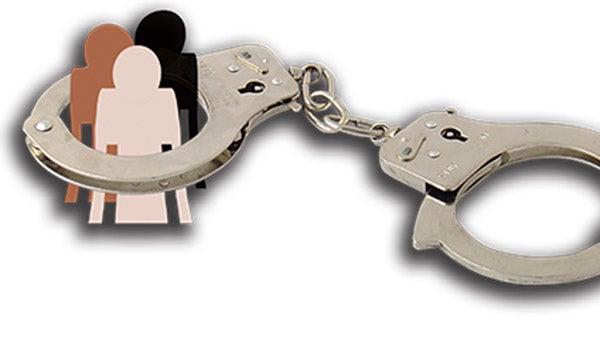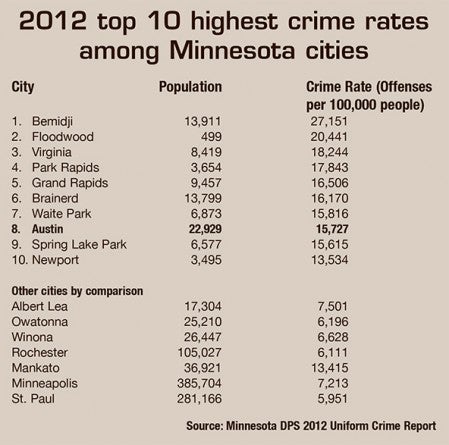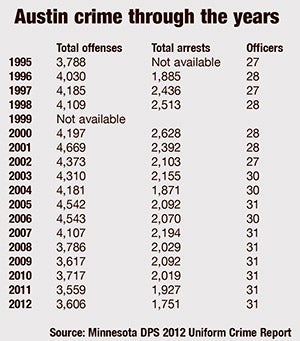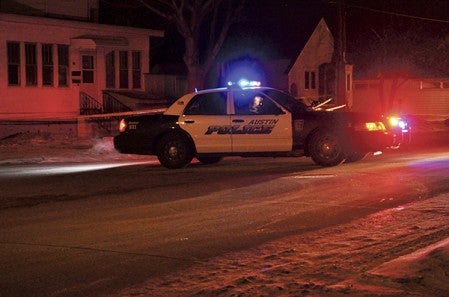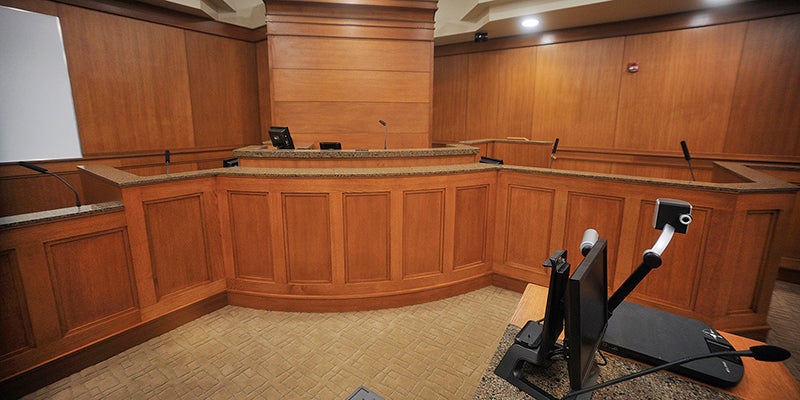Special Report: The truth about crime in Austin
Published 11:39 pm Monday, September 30, 2013
Part One in a two-part series.
For the past two decades, Austin’s crime rate has remained high. The reason is anyone’s guess, but city and county officials say there’s no easy solution. Some say the severity of particular offenses has risen, such as robbery and gang violence, along with drug use. While statistics may not clearly indicate that, those from law enforcement to the judicial system tell it like it is.
Mower County District Court Judge Donald Rysavy sat in his office, discussing the never-ending flow of the criminal court: first-time offenders, repeat offenders, drugs, the effect on taxpayers … the system.
A senior court clerk walked in and handed him six more case files.
Rysavy eyed them. At least nobody violated terms of release from jail, but some violated probation from past convictions. Nothing new. One man clearly didn’t understand how probation was supposed to work — or didn’t care. But, would this person be sent to prison?
It’s not so simple, and prison isn’t always the answer, as Rysavy has stated in the past. These are the issues local authorities, lawyers and judges have tussled with for a long time.
It’s been high for decades
For years, the level of crime in Austin has surpassed similar, and in many cases, larger communities.
“Austin has consistently had a crime rate and arrest rate higher than its sister cities,” said Austin Police Capt. Dave McKichan.
In fact, Austin has the eighth highest crime rate in the state, surpassing Rochester, Minneapolis and St. Paul. According to the Minnesota Department of Public Safety — which measures crime rate by figuring the number of crimes a community would have if its population were 100,000 — Austin’s crime rate was 15,727 in 2012, well above Albert Lea (7,501), Owatonna (6,196), Rochester (6,111), Minneapolis (7,213) and St. Paul (5,951).
Despite some opinion, though, crime hasn’t been spiraling out of control in Austin.
“If anything, you’ve seen a slight reduction in the last 10 to 15 years, and everyone is still working hard on that,” McKichan said.
Over the past 18 years, crime in Austin has stayed relatively static, according to the DPS. Total arrests have gone down over the past several years, from 2,092 arrests in 2009 to 1,751 arrests in 2012. And that’s almost 1,000 arrests fewer than the 2,628 arrests made by the Austin Police Department in 2000.
The same decrease can be seen in total offenses reported, total cases cleared by arrests and the overall crime level. Since the early 2000s, the arrest rate in Austin has slowly decreased.
There’s no easy explanation for Austin’s crime rate. Some believe the location on Interstate 90 makes it a prime location for the drug trade, while others point to high poverty and underemployment rates, as about 19 percent of Austin residents live in poverty while only 5 percent are unemployed. But are Austin’s crimes becoming more serious, more violent? That’s debatable.
A serious rash
Public defender Dan Donnelly is well aware of the crime rate in Austin. People constantly seek his help when they’re charged with a crime.
“I’ve been doing public defender work for almost 10 years,” Donnelly said. “I haven’t seen any significant rise or fall in the crime rate.”

Police tape blocks off a section of Fourth Street NW where a possible homicide took place in February.
When it comes to very serious crime, like attempted murder or criminal sexual conduct, there are going to be a few cases each year.
“From year to year you may have a couple more serious crimes,” Donnelly said. “Generally, you’re going to see one major case a year.”
However, 2012 and part of 2013 had some very notable crimes. A man was convicted of second-degree attempted murder after he hit another in the back of the head with a baseball bat in April 2012. One man stood off with police and threatened to shoot himself. Another, with a shotgun, hid in a cornfield and stood off with the sheriff, deputies and police for three hours before he was finally arrested.
Last November, someone fired gunshots at Lansing Corners event center north of Austin and struck five people. That case, still stalled, has left Mower County Sheriff Terese Amazi frustrated. Considering severity, Amazi agrees the past year and a half hasn’t been great.
Not even a week after the Lansing Corners shooting, a father and son fired shots at people inside of a car and struck one woman in the face — again near Lansing.
On Feb. 1 this year in Austin, a man reportedly killed his father after inflicting an injury to his head. The son later died in an ensuing high-speed chase with police. The coroner’s office and Bureau of Criminal Apprehension still won’t release details about the father’s injury. That same month, a group of men assaulted several teens near a gas station on Oakland Avenue in Austin. One assailant used a baseball bat and fractured a 17-year-old’s skull. A report indicates the whole scuffle may have been gang related.
Common denominator
While DPS data shows Mower County’s crime rate has been consistent after nearly 20 years, despite a few spikes, residents are reporting more serious crimes. Austin police have steadily received more calls for aggravated assault, simple assault, burglary and narcotics, along with a few more reports of robbery. Looking back decades ago, things aren’t the same.
“We’ve seen more gun violence with firearms being discharged or being used in crimes than when I started in my career,” said Austin Police Chief Brian Krueger, who joined the local force in 1984.
Krueger can’t point to one factor for Austin’s crime rate, but he echoed what many others have said: Chemical use often accompanies crime.
In some cases, people commit burglary or theft to fuel drug habits. In others, alcoholism accompanies assault or property damage. And in Mower County, those cases are more prevalent than in some nearby counties.
“I think the county has a higher incidence of chemical dependency than other counties do,” said Rysavy, who agreed on a correlation between chemical dependency, poverty and crime. He also noted the increase in burglaries. According to the Austin Police Department’s annual report, police received 129 burglary reports in 2008, then 158, 159, 159 and 164 in 2012. Police have also received more narcotics calls over the past five years, from 167 in 2008 to 258, 275, 234 and 280 in 2012. According to the DPS, there were 190 narcotics arrests in Mower in 2012, and 78 involved methamphetamine.
Rysavy worries about a recent spike in meth use, which may have dipped after restrictions were put on some over-the-counter medications several years ago. He anticipates another influx of meth cases. However, law enforcement officials say meth use never really waned. It has been here all along, coupled with an influx in heroin use in the last year or more.
About five to 10 people released from jail each week — regardless of the crime — violate terms of release, according to Rysavy. Of that group, half test positive for meth.
“That is truly scary,” he said. “Even more concerning is the fact people are wandering around our county, tweaking, getting high, and causing all sorts of trouble. And that’s just the tip of the iceberg.”
That iceberg being the countless other users who haven’t been caught or correctly punished, and who may commit more serious crimes. For example, a person originally arrested for assault or theft will be charged for that specific crime. If that person is released from jail and caught with meth, he or she may not face a drug charge, only a violation of release terms.
“They’re not even on the radar for a drug crime,” Rysavy said.
What’s worse, people who don’t want to kick drug addiction simply won’t. Probation violations and new criminal cases indicate that.
Nobody has a full grasp on the drug situation in Austin, either. Numbers, like arrests and convictions, never tell the whole story. Plenty of people use drugs on a regular basis but remain undetected.
“Rates of illegal drugs are hard to define because they are so much behind closed doors,” said McKichan, who has specialized in drug enforcement. “What we in law enforcement see is really behind closed doors. I think meth is as prevalent as it has ever been.”
That’s why county corrections programs exist for offenders. Mower County Corrections Director Steve King said many offenders have been helped by “cog skills” classes, or classes that teach offenders how to think differently about their behavior, and how to approach their lives and risky decisions with rational.
“The intent is to help anybody. In this case we’re dealing with probationers. Change the way they’re thinking, change their thought process,” he said.
In addition, classes for issues like domestic violence, drug abuse and DWI may cut down on repeat offenders. Though the county doesn’t track the number of people who repeat crimes, King said anecdotal evidence supports the need for such classes.
“Our people that complete cog skills class come to us on far fewer occasions,” he said.
Still, King admits, there is little county officials can do to pinpoint reasons why people are committing crimes in the area, and what can be done to help.
Looking over many decades, Rysavy said, it’s as though Austin has gone from a hard-drinking and hardworking town to one that slowly mixed in drugs, a trend in many cities.
Out of their hands
Many are quick to say prison is the answer. Usually, though, that’s not even an option.
“Judges and prosecutors don’t have as much discretion in that regard as people would think,” Rysavy said, scanning over a table in one of his many law books.
Judges have to follow the state’s sentencing guidelines, which usually means more probation and sometimes local jail time.
“Half of the guidelines are mandatory probation,” said Mower County Attorney Kristen Nelsen.
If judges and prosecutors had more power, they say they would use it.
“If they fall in the probation grid, they get probation, and there’s nothing we can do about that,” Nelsen said. “Do I think sometimes people get too many chances when they violate their probation? Yes.”
Donnelly has noticed more probation violations in recent years. Sometimes the same names in those case files make the crime rate look a little higher.
“If anything, I think there seems to be more people who tend to violate their terms of probation than maybe we had four, five, six years ago,” he said.
Some say that begs the question, are cognitive skill classes are working?
Regardless, sentencing guidelines often suggest violators be put back on probation, and judges say they can’t in good conscience flood prisons without the most significant reasons. As Rysavy puts it, it’s simply “warehousing them” until they re-offend after release. The system is cyclical, no matter what anybody does. Rysavy wants to save prison sentences for keeping the most dangerous people off the streets, then for violators who clearly aren’t taking probation seriously.
Yet Donnelly believes people are often going to prison when necessary. He points to cases like the February assault on Oakland, mentioned above. In that case, one assailant has gone to prison.
“Every month people are going to prison from Austin, but it may not be initially at sentencing because courts give them a chance to be good probationers,” he said.
Throw the book?
Rysavy said it’s easier for people to call for prison sentencing if they don’t know the defendants, don’t have to deal with them in person and don’t fully understand how the penal system will permanently affect families. Then there’s the question of whether prison will actually effect change. That’s why, like King, Rysavy is more interested in cognitive programs than he was in the past. After all, he says, “It’s still a people business.”
Though having more power to sentence criminals would be nice in some cases, the sentencing guidelines exist for a reason. They prevent what Rysavy calls a “rogue judge,” who issues unnecessary prison time, and overburdens state prisons and taxpayers. At the end of the day, it’s still a balancing act between the appropriate course of legal action and the best outcome for taxpayers. Rysavy still believes Mower does well in that regard. Nelsen agrees.
Several months ago the Mower County Board asked Nelsen how the crime rate and caseload affected her office. She told the board Austin and Mower County rank 14th in the state in total arrests. Her office handles a high caseload with the minimum number of attorneys — what a county should want. Nelsen wasn’t asking for more help.
“I want that clear: I’m not asking for another lawyer,” she said. “Taxpayers should understand that we have the same number of arrests as large places, and we don’t have the same number of staff. They are truly getting their bang for their buck.”
Rysavy is aware of Mower County’s crime rate, too. Some weekdays, he and Judge Fred Wellmann’s court calendars are so congested, it seems there wouldn’t be enough time in the day to hear every case. But they often do. Still, Rysavy doesn’t think Mower’s crime is out of control.
“I don’t think it’s super high,” he said, “but it is definitely higher per capita from the rest of the district.”
As the clock hit 11 a.m. on a Friday, another court worker signaled it was time. Rysavy threw on the robe and headed toward Courtroom 1, where he had another half-dozen cases to overhear. The day wasn’t half done, and he needed to be in Rochester by 2 p.m. Other counties have their issues, too.
Trey Mewes contributed to this story.


